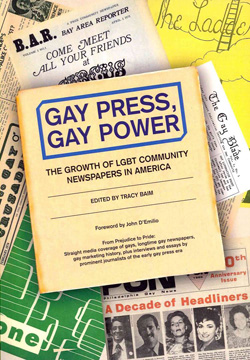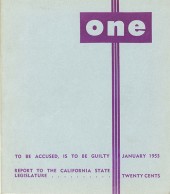 Gay Press, Gay Power:
Gay Press, Gay Power:
The Growth of LGBT Community Papers in America
Edited by Tracy Baim
Published by Prairie Avenue Productions and Windy City Media Group
Published November 24, 2012
History: journalism • 468 pages
Find on Amazon.com
Order from Giovanni’s Room
Review by Billy Glover
 February 17, 2013.
February 17, 2013.
While there have been several books and efforts to discuss the history of publications in the lgbt movement / community, at last there is one that contains the basic research and expertise needed to pull into one place the basic facts, names, and information of the magazines, newspapers, newsletters that recorded that history which they helped to make. This book, Gay Press, Gay Power,edited by Tracy Baim, covers many of our movement’s publications from the start in the early 1950s to 2012. It contains new information, corrects some misinformation, and provides us with rich biographical information on the pioneering journalists who worked on these publications.
To put the history in context, there is a discussion, with examples, of the horrible coverage the media gave homosexuality until about the late 1960s, when coverage exploded after Stonewall. The publications started with the movement to gain equal rights for homosexual Americans, and thus this civil rights movement is documented by the very people who were active in the effort. A historian or researcher trying to see how coverage changed from the 1950s on could see the evidence by looking through editions of the Readers Guide to Periodicals Index. Baim has done this for the reader.
The first publications are discussed in full in an early chapter by C. Todd White. They started during the worst of times, the McCarthy era when homosexuals and Communists were considered to be allies and were labeled as threats to the nation’s security.

The first publicly available publication (1953), ONE, suffered from the same problems all early ones did: little income, people afraid to have their names as subscribers to a homosexual publication, businesses afraid to place ads, and few authors or journalists of note willing to let their names appear in the publication.
There was also a problem few other causes had: there were homosexual people in hiding who tried to keep their sexuality from being questioned or discovered by loudly protesting the existence of a publication discussing homosexuality. Many such people later were arrested for homosexual acts and still refused to support the effort to educate the public and change laws.
But ONE was successful, and was joined by the Mattachine Review and then The Ladder, aimed toward women.
The editors of ONE, led by Don Slater and attorney Eric Julber, fought a legal battle with the Post Office to protect its right to publish and mail a magazine subtitled “The Homosexual Viewpoint” and won only at the U.S. Supreme Court level in 1958. (For more on this, see Murdoch and Price: Courting Justice.) These three magazines were slowly joined by others each few years, and together they planted the seeds that are the major media the lgbt movement/community has today.
The early publications were supported by an organization. Today, most are independent.
The book is loaded with pictures of most of the publications covered—a great help as it shows the progression from early publications to those of today. As White says, they are “time capsules of their era.” One clue to how things have changed is in observing the terms used in the three eras. First they were called homophile publications, then homosexual, then gay and, now gay and lesbian or lgbt.
Gay Press, Gay Power includes short biographies of some lgbt journalists who helped make the publications successful. The index catalogs the large number of people covered and names hundreds of current LGBT publications.
Many readers will gain a sense of pride knowing the history of the GLBT media’s growth from ONE to the hundreds of publications that exist today, currently giving the community news and views, entertainment and education, continuously revitalizing those who seek to make life better for everyone and to make this a more perfect nation, for all citizens.
No historian or journalist can write on the subject without knowing the contents of this book because the history of a movement is told through the history of its publications.
See also:
- Rachel Wexelbaum’s review of Gay Press, Gay Power, published 02/19/13 on the Lambda Literary website
- An interview with Tracy Baim by Tony Adams, published 01/03/13 of the South Florida Gay News
- Rick Kogan’s article “Tracy Baim: a gay media torchbearer,” published on 02/28/13 by the Chicago Tribune

